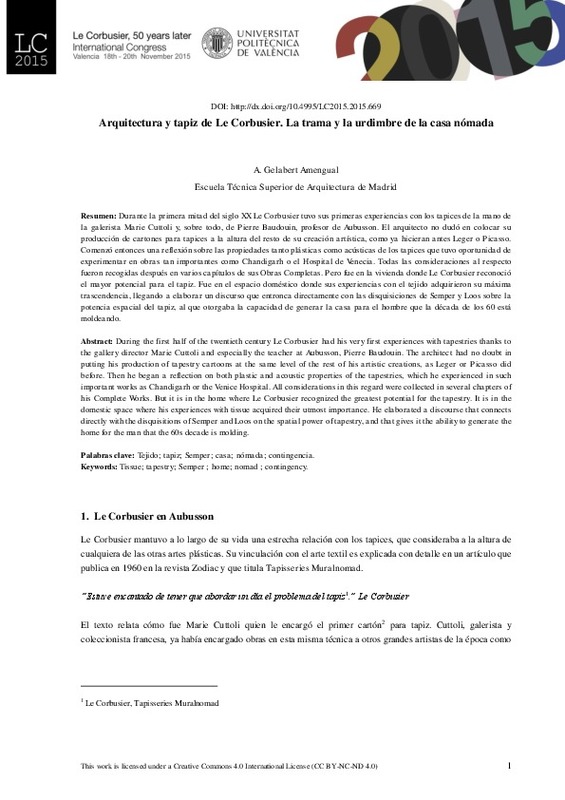JavaScript is disabled for your browser. Some features of this site may not work without it.
Buscar en RiuNet
Listar
Mi cuenta
Estadísticas
Ayuda RiuNet
Admin. UPV
Arquitectura y tapiz de Le Corbusier. La trama y la urdimbre de la casa nómada
Mostrar el registro sencillo del ítem
Ficheros en el ítem
| dc.contributor.author | Gelabert Amengual, Antoni
|
es_ES |
| dc.date.accessioned | 2017-09-11T06:39:37Z | |
| dc.date.available | 2017-09-11T06:39:37Z | |
| dc.date.issued | 2016-03-03 | |
| dc.identifier.isbn | 9788490483732 | |
| dc.identifier.uri | http://hdl.handle.net/10251/86893 | |
| dc.description.abstract | [EN] During the first half of the twentieth century Le Corbusier had his very first experiences with tapestries thanks to the gallery director Marie Cuttoli and especially the teacher at Aubusson, Pierre Baudouin. The architect had no doubt in putting his production of tapestry cartoons at the same level of the rest of his artistic creations, as Leger or Picasso did before. Then he began a reflection on both plastic and acoustic properties of the tapestries, which he experienced in such important works as Chandigarh or the Venice Hospital. All considerations in this regard were collected in several chapters of his Complete Works. But it is in the home where Le Corbusier recognized the greatest potential for the tapestry. It is in the domestic space where his experiences with tissue acquired their utmost importance. He elaborated a discourse that connects directly with the disquisitions of Semper and Loos on the spatial power of tapestry, and that gives it the ability to generate the home for the man that the 60s decade is molding. | es_ES |
| dc.description.abstract | [ES] Durante la primera mitad del siglo XX Le Corbusier tuvo sus primeras experiencias con los tapices de la mano de la galerista Marie Cuttoli y, sobre todo, de Pierre Baudouin, profesor de Aubusson. El arquitecto no dudó en colocar su producción de cartones para tapices a la altura del resto de su creación artística, como ya hicieran antes Leger o Picasso. Comenzó entonces una reflexión sobre las propiedades tanto plásticas como acústicas de los tapices que tuvo oportunidad de experimentar en obras tan importantes como Chandigarh o el Hospital de Venecia. Todas las consideraciones al respecto fueron recogidas después en varios capítulos de sus Obras Completas. Pero fue en la vivienda donde Le Corbusier reconoció el mayor potencial para el tapiz. Fue en el espacio doméstico donde sus experiencias con el tejido adquirieron su máxima trascendencia, llegando a elaborar un discurso que entronca directamente con las disquisiciones de Semper y Loos sobre la potencia espacial del tapiz, al que otorgaba la capacidad de generar la casa para el hombre que la década de los 60 está moldeando. | es_ES |
| dc.format.extent | 7 | es_ES |
| dc.language | Español | es_ES |
| dc.publisher | Editorial Universitat Politècnica de València | es_ES |
| dc.relation.ispartof | LE CORBUSIER. 50 AÑOS DESPUÉS | es_ES |
| dc.rights | Reconocimiento - No comercial - Sin obra derivada (by-nc-nd) | es_ES |
| dc.subject | architecture | es_ES |
| dc.subject | le corbusier | es_ES |
| dc.subject | modern movement | es_ES |
| dc.title | Arquitectura y tapiz de Le Corbusier. La trama y la urdimbre de la casa nómada | es_ES |
| dc.type | Capítulo de libro | es_ES |
| dc.type | Comunicación en congreso | es_ES |
| dc.identifier.doi | 10.4995/LC2015.2015.669 | |
| dc.rights.accessRights | Abierto | es_ES |
| dc.description.bibliographicCitation | Gelabert Amengual, A. (2016). Arquitectura y tapiz de Le Corbusier. La trama y la urdimbre de la casa nómada. En LE CORBUSIER. 50 AÑOS DESPUÉS. Editorial Universitat Politècnica de València. 819-826. https://doi.org/10.4995/LC2015.2015.669 | es_ES |
| dc.description.accrualMethod | OCS | es_ES |
| dc.relation.conferencename | LC2015 - Le Corbusier, 50 years later | es_ES |
| dc.relation.conferencedate | November 18-20,2015 | es_ES |
| dc.relation.conferenceplace | Valencia, Spain | es_ES |
| dc.relation.publisherversion | http://ocs.editorial.upv.es/index.php/LC2015/LC2015/paper/view/669 | es_ES |
| dc.description.upvformatpinicio | 819 | es_ES |
| dc.description.upvformatpfin | 826 | es_ES |
| dc.type.version | info:eu-repo/semantics/publishedVersion | es_ES |
| dc.relation.pasarela | OCS\669 | es_ES |








